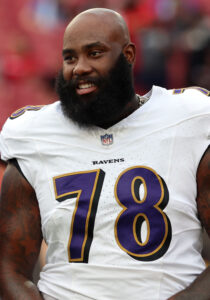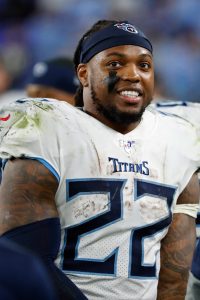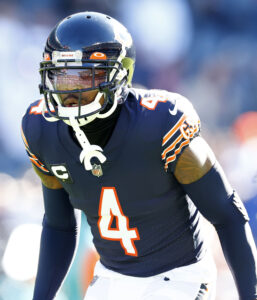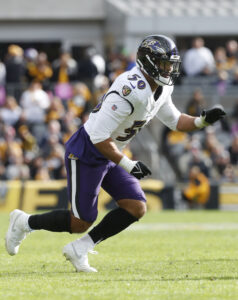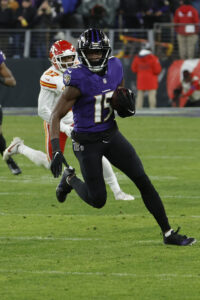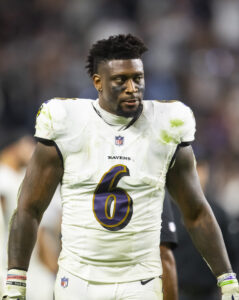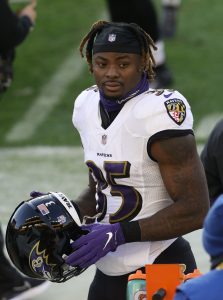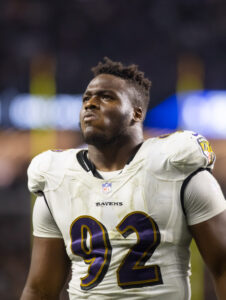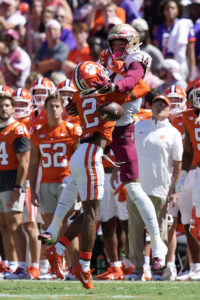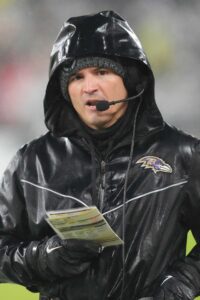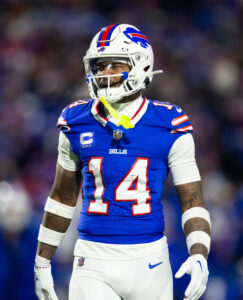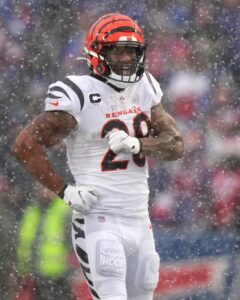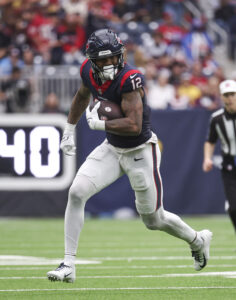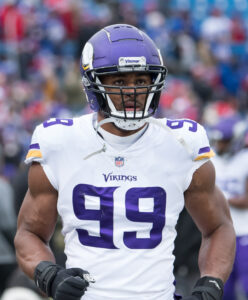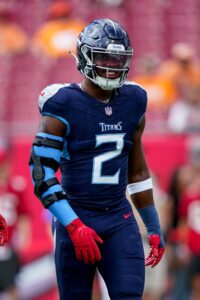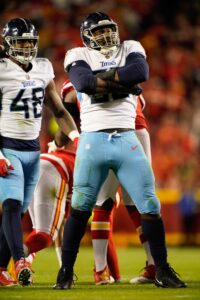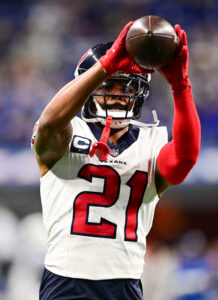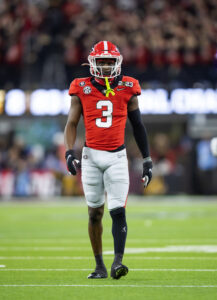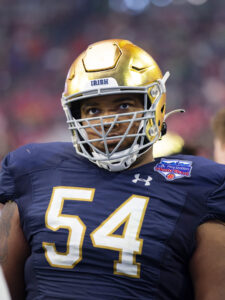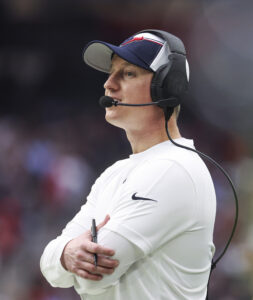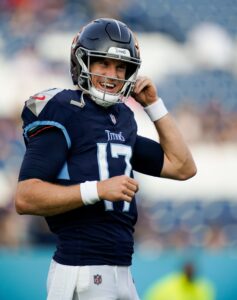The quest to find a long-term quarterback has dominated Broncos discourse since Peyton Manning‘s 2016 retirement, and while the organization’s failures here were not particularly costly during the initial years following the all-time great’s exit, the most recent effort certainly was. As a result of the Russell Wilson tenure, the Broncos became a punching bag for a season before seeing some 2023 improvements drop their 2024 draft slot. Now, they are in Year 1 of a dead money abyss unlike anything any team has encountered.
Bailing on Wilson’s pricey extension set a record that will be difficult to break for the foreseeable future, and the Broncos are taking another swing at quarterback — this one handpicked by Sean Payton. Making other notable subtractions and contract adjustments after making strides under Payton, the Broncos will attempt to field a competitive team despite Wilson’s contract consuming a significant chunk of their salary cap.
Extensions and restructures:
 The Broncos are still using the phonetically interesting Payton-Paton power duo. GM George Paton was the point man behind three of this decade’s worst decisions — the Nathaniel Hackett hire, the Wilson trade and then the QB’s extension — but the group he drafted in 2021 has developed nicely. Paton plucked starters Patrick Surtain, Javonte Williams, Baron Browning and Jonathon Cooper in his first draft, but the biggest success story is probably a third-round guard from the Division III ranks. Meinerz has been a regular starter in Denver since midway through his rookie year, and he became the first Paton-era draftee to see his contract extended.
The Broncos are still using the phonetically interesting Payton-Paton power duo. GM George Paton was the point man behind three of this decade’s worst decisions — the Nathaniel Hackett hire, the Wilson trade and then the QB’s extension — but the group he drafted in 2021 has developed nicely. Paton plucked starters Patrick Surtain, Javonte Williams, Baron Browning and Jonathon Cooper in his first draft, but the biggest success story is probably a third-round guard from the Division III ranks. Meinerz has been a regular starter in Denver since midway through his rookie year, and he became the first Paton-era draftee to see his contract extended.
Meinerz, 25, impressed at the 2021 Senior Bowl — a vital component of his rise, as the COVID-19 pandemic nixed the non-Division I-FBS levels’ 2020 seasons — and replaced an injured Graham Glasgow in 2021. Meinerz beat out Glasgow for the Broncos’ right guard gig in 2022 and graded as a top-10 guard, per Pro Football Focus, over the past two seasons. Excelling in the run game, Meinerz was probably the Broncos’ top offensive player during the Wilson years. The team will bet on upside, as no Pro Bowls are yet on the Wisconsin-Whitewater alum’s resume.
Although Louis Vasquez rewarded the Broncos, the team has struggled with guard payments over the past several years. Neither Glasgow nor Ronald Leary justified their high price tags under John Elway, and the Payton-Paton pair has now doubled down at guard. The team gave Ben Powers a four-year, $52MM deal in 2023. The ex-Raven appears locked in for at least two more seasons, as the team restructured his contract to create 2024 cap space. Bo Nix‘s rookie contract stands to help the Broncos afford big payments elsewhere on the roster, though Wilson’s $83MM-plus in dead money from 2024-25 undercuts that advantage.
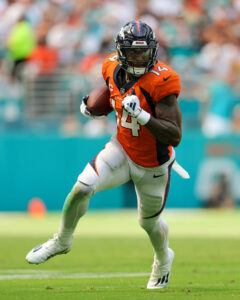 Denver paying Meinerz also clouds Garett Bolles‘ future. Meinerz’s terms match Denver’s left tackle for the most lucrative O-line contract in team history, and with right tackle Mike McGlinchey also on an upper-crust contract at his position, it is fair to wonder if Bolles is entering his final season with the team.
Denver paying Meinerz also clouds Garett Bolles‘ future. Meinerz’s terms match Denver’s left tackle for the most lucrative O-line contract in team history, and with right tackle Mike McGlinchey also on an upper-crust contract at his position, it is fair to wonder if Bolles is entering his final season with the team.
Bolles, 32, is in a contract year and has angled for a second extension. No known negotiations have transpired. The Meinerz payment points to the Broncos rolling with three pricey O-line contracts and looking for Bolles’ successor next year. For now, Denver is the rare team with four eight-figure O-line deals on its payroll. This is in step with Payton’s approach in New Orleans, where early-round O-line draft choices and extensions were commonplace.
Sutton, 28, reemerged as Denver’s top wide receiver last season, overtaking Jerry Jeudy as Wilson’s favorite target. Snaring some snazzy touchdown receptions, Sutton played a central role in the Broncos’ five-game midseason win streak. With Jeudy traded, Sutton stands as more important regarding Nix’s development. Days before the Broncos made their Nix pick, Sutton lobbied for a contract adjustment. The Broncos have their top target at a below-market rate thanks to an extension (four years, $60MM) authorized back in 2021 — shortly before the 2022 offseason changed the position’s landscape — and the team did not give in.
Denver waited out Sutton, who showed for minicamp after missing the offseason program, and incentives became the endgame here. The team gave the seventh-year vet a $1.7MM incentive package, reminding of the Chargers’ low-level resolution with Austin Ekeler last year. Sutton can increase his earnings to $15.2MM this year but remains tied to a contract with just $2MM guaranteed for 2024 and no guarantees in place for 2025.
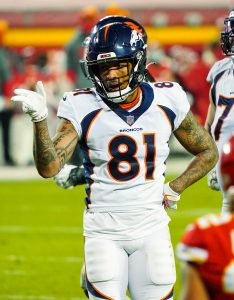 As a vested veteran, the rest of Sutton’s $13MM base salary will become guaranteed just before Week 1. But the long-running trade candidate — teams called on the former second-rounder in April and figure to again soon — was unable to secure a notable contract update, putting the pre-Payton pickup’s long-term Denver future in doubt.
As a vested veteran, the rest of Sutton’s $13MM base salary will become guaranteed just before Week 1. But the long-running trade candidate — teams called on the former second-rounder in April and figure to again soon — was unable to secure a notable contract update, putting the pre-Payton pickup’s long-term Denver future in doubt.
Patrick, 30, has managed to hang around despite two season-nullifying injuries. After serving as a key target for Drew Lock and Teddy Bridgewater, Patrick did not play a down with Wilson. After summer ACL and Achilles tears, the former UDFA — the second-longest-tenured Bronco, behind Bolles — accepted a pay cut down to the veteran minimum to stay. Patrick signed a three-year, $30MM extension days before the Broncos paid Sutton. The Broncos brought in Patrick under Elway, and despite his back-to-back 700-plus-yard seasons from 2020-21, the 6-4 wideout — healthy once again — is a wild card in this revamped position group.
Trades:
Rumblings of the Jeudy-Sutton tandem — after four years and incessant trade rumors together — separating emerged early this offseason. Jeudy trade rumors date back to the 2022 deadline, and they followed the former first-round pick into the 2023 offseason and up to last year’s deadline. The Broncos hoped the Elway-era draftee could help Wilson rebound in 2023, and they set a lofty asking price (a first-rounder) in trades last year. Before the deadline, Denver received an offer involving third- and fifth-round picks. Amid their midseason turnaround that included a win over the Chiefs just before the deadline, the Broncos declined and ultimately moved on for less months later.
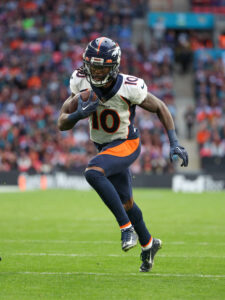 The Browns are still betting on the 2020 first-rounder unlocking upside that did not materialize in Denver. Jeudy flashed crafty route-running chops and delivered a strong finish to the 2022 season but ended his Broncos tenure 0-for-4 in 1,000-yard seasons. In the Alabama alum’s defense, the Broncos featured five play-callers (three in 2022) and mostly below-average quarterback play during the inconsistent wideout’s career.
The Browns are still betting on the 2020 first-rounder unlocking upside that did not materialize in Denver. Jeudy flashed crafty route-running chops and delivered a strong finish to the 2022 season but ended his Broncos tenure 0-for-4 in 1,000-yard seasons. In the Alabama alum’s defense, the Broncos featured five play-callers (three in 2022) and mostly below-average quarterback play during the inconsistent wideout’s career.
The Browns will pair Jeudy with Amari Cooper, and the AFC North club went as far as to extend Jeudy (three years, $52.5MM; $41MM guaranteed) and provide only incentives for Cooper, whose contract issue ended similarly to Sutton’s. Marvin Mims, who made some noise as a deep threat as a rookie but could not earn a steady role, will be given a good chance to replace Jeudy as a starter.
As the Jets attempted to clear salary to make room for Haason Reddick‘s contract, they dealt the Broncos a quality starter for next to nothing during the draft. Acquired in a salary-dump deal, Franklin-Myers became a more favorable Broncos asset after redoing his contract (now at two years and $15MM; $8MM guaranteed) post-trade. The Jets offered Franklin-Myers — a three-year starter for the team — a pay cut, but the seventh-year vet confirmed it was at a lower rate compared to his new Broncos salary.
The Jets had given Franklin-Myers a four-year, $55MM extension early during the 2021 season, and he started 52 games with the team. The former Rams draftee saw time both inside and outside in Robert Saleh‘s 4-3 scheme; in Vance Joseph‘s 3-4 setup, Franklin-Myers will line up as a D-end. Producing six- and five-sack seasons in 2021 and ’22, respectively, Franklin-Myers registered 48 QB hits over the past three years. He profiles as a low-risk upgrade up front and will form a veteran-laden D-line with Allen and D.J. Jones.
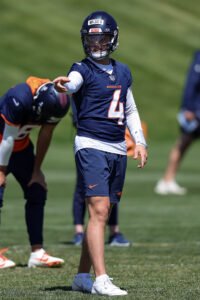 Paton had said the Broncos planned to acquire a veteran to join Jarrett Stidham, and weeks after the team looked into Sam Darnold, the trade for Wilson was finalized. Conflicting reports about a Broncos Darnold offer emerged, but the former Jets starter preferred the Vikings. After Minnesota gave Darnold a one-year, $10MM deal, Denver reached a salary-split trade agreement for Wilson.
Paton had said the Broncos planned to acquire a veteran to join Jarrett Stidham, and weeks after the team looked into Sam Darnold, the trade for Wilson was finalized. Conflicting reports about a Broncos Darnold offer emerged, but the former Jets starter preferred the Vikings. After Minnesota gave Darnold a one-year, $10MM deal, Denver reached a salary-split trade agreement for Wilson.
Wilson fared worse than Darnold did in New York — to the point the Jets benched the former No. 2 overall pick three times from 2022-23 — and exited the offseason program as a long-shot candidate to land even the Broncos’ backup job. The Broncos would eat $2.73MM in dead money by cutting Wilson; they would take on $2MM by releasing Stidham. A Stidham cut would, however, save the team $5MM.
After a year and change in Payton’s system, Stidham looks to have a leg up on the erratic BYU product. A No. 2 overall pick being waived before his fourth season would represent an ignominious start to a career and place Wilson on the short list of biggest QB busts in NFL history.
Free agency additions:
- Brandon Jones, S. Three years, $20MM ($11MM guaranteed)
- Josh Reynolds, WR. Two years, $9MM ($4.25MM guaranteed)
- Malcolm Roach, DL. Two years, $7MM ($3MM guaranteed)
- Cody Barton, LB. One year, $2.5MM ($2.33MM guaranteed)
- Levi Wallace, CB. One year, $1.29MM ($668K guaranteed)
- Matt Peart, T. One year, $1.29MM ($368K guaranteed)
- Angelo Blackson, DL. One year, $1.38MM ($168K guaranteed)
- Sam Mustipher, C. One year, $1.13MM
- Andre Smith, LB. One year, $1.13MM
- Calvin Throckmorton, OL. One year, $1.1MM
- Trenton Gill, P. One year, $1MM
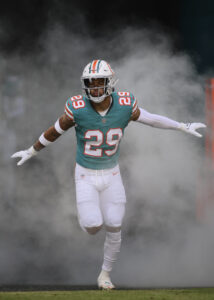 A year after big-ticket deals for McGlinchey, Powers and Allen, Denver — navigating historic cap consequences — operated conservatively in free agency. Its most notable 2024 expense was a safety that will be expected to replace Justin Simmons (or try). The Dolphins took Jones in the 2020 second round and used him as a full-time starter in 2021 and ’22, but the Jevon Holland back-line tandem partner lost a competition to DeShon Elliott last summer.
A year after big-ticket deals for McGlinchey, Powers and Allen, Denver — navigating historic cap consequences — operated conservatively in free agency. Its most notable 2024 expense was a safety that will be expected to replace Justin Simmons (or try). The Dolphins took Jones in the 2020 second round and used him as a full-time starter in 2021 and ’22, but the Jevon Holland back-line tandem partner lost a competition to DeShon Elliott last summer.
Elliott started over Jones under Vic Fangio, though the former Broncos HC used Jones in three-safety looks. Elliott outsnapped Jones 967-542 last year, but the latter graded as a top-20 safety in PFF’s view. Also showing a blitz acumen under Brian Flores with five sacks in 2021, Jones will team with two ex-Texas Longhorn teammates — Caden Sterns and P.J. Locke — in Denver.
Spending nearly his entire career as an auxiliary Jared Goff target, Reynolds looks to be both insurance against Patrick not resembling his pre-injury version and Mims and fourth-rounder Troy Franklin not developing as the team hoped. Reynolds’ $4.5MM guarantee suggests a clear role. Not as explosive as Jeudy, Reynolds ranked 85th among wideouts in ESPN’s open score metric last season. The ex-Rams regular is known more for his long-range skills and run-blocking chops than being a pure separator, but he did tally 608 yards and a career-high five touchdowns last season. Though, Reynolds’ campaign ended with two drops during Detroit’s NFC championship game collapse.
Read more
 Denver’s contracts make a Sutton-Mims-Reynolds starting trio the most likely Week 1 outcome. Reynolds has started 53 games, being the Lions’ insurance option with Jameson Williams regularly unavailable. The Broncos look to need Sutton this year, but if Mims and Franklin become capable starters, Reynolds provides a veteran presence that could lead to Denver listening on Sutton once again if teams make worthwhile offers before the November deadline.
Denver’s contracts make a Sutton-Mims-Reynolds starting trio the most likely Week 1 outcome. Reynolds has started 53 games, being the Lions’ insurance option with Jameson Williams regularly unavailable. The Broncos look to need Sutton this year, but if Mims and Franklin become capable starters, Reynolds provides a veteran presence that could lead to Denver listening on Sutton once again if teams make worthwhile offers before the November deadline.
Barton appears the favorite to start alongside Alex Singleton; Jonas Griffith (eight 2022 starts) has missed the past 1 1/2 seasons. Barton has started for the past two, working as a regular in Seattle and Washington. PFF ranked Barton 74th among off-ball LBs last season.
For now, Wallace offers a Reynolds-like profile at cornerback. The former Bills and Steelers starter supplies low-cost insurance against 2023 third-rounder Riley Moss not being ready to start opposite Surtain. The Steelers, however, benched Wallace midway through last season. The 29-year-old former UDFA still has 70 career starts, including 52 in Buffalo, being present as the team vaulted onto the AFC’s top tier.
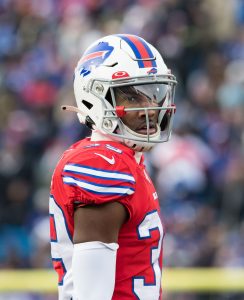 Although the Alabama alum allowed career-low completion rates as the closest defender over the past two seasons in Pittsburgh (53%), the Steelers did not give him the same usage rate. The Broncos also sought former Titans starter Kristian Fulton for this gig, making an offer before he signed a modest Chargers deal.
Although the Alabama alum allowed career-low completion rates as the closest defender over the past two seasons in Pittsburgh (53%), the Steelers did not give him the same usage rate. The Broncos also sought former Titans starter Kristian Fulton for this gig, making an offer before he signed a modest Chargers deal.
Bidding to become the first white cornerback to start an NFL game since the Bengals deployed future safety Kevin Kaesviharn there in 2003, Moss spent his rookie season playing special teams. A summer surgery set the Iowa alum back, but the Broncos traded a 2024 third-round pick to move back into Round 3 for Moss last year. Intercepting 11 passes at Iowa, Moss is firmly in the mix to start. The Broncos, who benched 2022 starter Damarri Mathis early last season, need a CB2 answer soon. That has been an issue for most of Surtain’s career. Whoever wins this job will be targeted relentlessly due to Surtain’s reputation.
Re-signings
- Adam Trautman, TE. Two years, $7.5MM ($5MM guaranteed)
- Wil Lutz, K. Two years, $8.4MM ($4.51MM guaranteed)
- P.J. Locke, S. Two years, $7MM ($3.25MM guaranteed)
- Michael Burton, FB. One year, $1.38MM ($168K guaranteed)
- Lil’Jordan Humphrey, WR. One year, $1.13MM
 It is a bit surprising the Broncos will continue to hope Greg Dulcich, who has made four trips to IR in two seasons, can stay healthy. The team looked into tight ends in free agency but will roll out the same group in 2024. Due to Dulcich’s hamstring injuries, Trautman led the 2023 team’s TEs in receiving (with just 204 yards). PFF did, however, rank the former Saint in the top 15 in run blocking at the position.
It is a bit surprising the Broncos will continue to hope Greg Dulcich, who has made four trips to IR in two seasons, can stay healthy. The team looked into tight ends in free agency but will roll out the same group in 2024. Due to Dulcich’s hamstring injuries, Trautman led the 2023 team’s TEs in receiving (with just 204 yards). PFF did, however, rank the former Saint in the top 15 in run blocking at the position.
As Trautman will be set to continue helping in the run game, Dulcich and ex-Saints UDFA Lucas Krull — whose role will expand after some late-season promise (and likely due to Dulcich’s unreliability) — are in line to operate more as pass catchers. Dulcich missed Denver’s entire offseason program, an ominous sign for the former third-rounder’s bounce-back hopes.
A more notable ex-Saint, Lutz had agreed to terms with the Jaguars during the tampering period before backtracking and recommitting to the Broncos. Lutz’s 88.2% make rate last year (30-for-34) was his best showing since his 2019 Pro Bowl season.
Seldom used over his first three seasons, Locke submitted some quality efforts upon replacing Kareem Jackson during his two-suspension season. Making eight starts, Locke added three sacks, two forced fumbles last season and eventually wrested the job from Jackson. With Sterns not starting camp on time after missing almost all of last season, Locke is positioned to start once again.
Notable losses:
- Lloyd Cushenberry, C
- Cameron Fleming, T
- Jonathan Harris, DL
- Josey Jewell, LB
- Chris Manhertz, TE (released)
- Fabian Moreau, CB
- Ben Niemann, LB
- Mike Purcell, DT
- Justin Simmons, S (released)
- Dwayne Washington, RB
- K’Waun Williams, CB
- Russell Wilson, QB (post-June 1 cut)
 Performance-wise, worse trades have been made throughout NFL history. Financially, the Broncos’ blunder pushes their 2022 effort to the top tier. Denver’s trade included two first-rounders, two seconds and four other assets (including tight end Noah Fant), and it became quickly apparent Wilson would not be the same outside the confines of an offense carefully constructed for him.
Performance-wise, worse trades have been made throughout NFL history. Financially, the Broncos’ blunder pushes their 2022 effort to the top tier. Denver’s trade included two first-rounders, two seconds and four other assets (including tight end Noah Fant), and it became quickly apparent Wilson would not be the same outside the confines of an offense carefully constructed for him.
The Broncos shoving Wilson into Nathaniel Hackett‘s offense proved catastrophic, as the team empowered its QB to an alarming level. Combining that with an overmatched coach brought in Payton, who tired of Wilson’s off-schedule routine to the point sideline tirades and a much-discussed benching wrapped a disastrous tenure. Wilson offered a bit of a rebound, throwing 26 touchdown passes and eight interceptions, under Payton but still ranked 21st in QBR last season.
The Steelers will hope Wilson has something left, as the 35-year-old QB was effective — albeit in a limited role — during the Broncos’ five-game run that revived their season. But Denver needing to hit the reset button so soon again highlights the franchise’s defining modern problem. Stidham was the Broncos’ 13th starting quarterback post-Manning, with Nix set to push that number higher. The team will aim for the first-rounder to be the solution, but Nix-centered rosters will take early hits thanks to the Wilson contract.
Broncos management attempting to convince Wilson to move his guarantee vesting date back from 2024 to 2025 could have conceivably kept him on the 2024 team. But a 2025 cut would have been just as expensive once the QB’s $37MM guarantee (his 2025 base salary) vested in March 2024. Given Payton’s enthusiasm for Nix, Wilson would have enjoyed no real future in Denver. Agreeing to move his vesting date would have removed security for Wilson, and although his play over the past two seasons made his five-year, $245MM contract well out of step, the nine-time Pro Bowler capitalized on leverage and signed it before playing a down in Denver. Had the Broncos waited until 2023 to pay Wilson, they probably avoid this dead money mess. But the team wanted to beat the market, anticipating a spree of 2023 QB deals to reset it. The club was correct there, but it bet on the wrong quarterback.
 The March release tagged the Broncos with $84.6MM in dead money in total. The Falcons’ 2022 Matt Ryan trade brought the previous single-player record ($40.5MM); the Broncos will eclipse that by a wide margin this year.
The March release tagged the Broncos with $84.6MM in dead money in total. The Falcons’ 2022 Matt Ryan trade brought the previous single-player record ($40.5MM); the Broncos will eclipse that by a wide margin this year.
A post-June 1 designation was necessary here, and the Broncos will take the bigger cap hit ($53MM) in 2024. Wilson’s veteran-minimum Steelers accord will give the Broncos a 2025 cap credit, but the 2022 extension’s guarantees will still call for a $30MM-plus dead money hit. The Broncos cut bait on what Payton deemed a sunk cost, but that cost will hamstring the Super Bowl-winning HC early in his tenure.
By comparison, Simmons’ exit is far less noteworthy. But the eight-year veteran safety was probably the Broncos’ second-best player. Targeting Simmons’ four-year, $61MM contract to help create cap space in the wake of the Wilson dead money avalanche made sense, but the release will obviously weaken Denver’s secondary. Simmons had anchored that unit for several years.
While the team’s Super Bowl-winning No Fly Zone secondary was trending downward, Simmons still paired with a few of its members during his ascent. The former third-round pick, chosen two months after the team’s parade, has intercepted an NFL-most 30 passes since 2016. One of the few Broncos who has given Patrick Mahomes trouble, Simmons earned four second-team All-Pro honors in the past five seasons. He and Surtain helped the Broncos’ defense keep the team in games during its dysfunctional 2022, and the Boston College alum’s absence during the Dolphins’ 70-point eruption was telling.
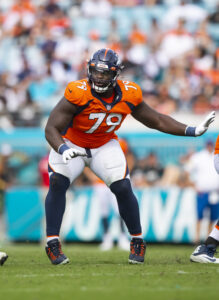 Simmons, 30, and Jewell were the only two defensive holdovers remaining from Joseph’s HC stay. Jewell reunited with Ejiro Evero in Carolina. Jewell, 29, was the team’s primary ILB alongside Singleton for the past two seasons. While the Broncos talked with the seventh-year veteran’s camp at the Combine and had not given up on re-signing him as free agency began, they passed as the Panthers added him at three years and $18.75MM ($10.13MM guaranteed). The Broncos were not in position to match that this year. Jewell started 58 games in Denver and ended his tenure with a 108-tackle, two-sack season that included two forced fumbles and three recoveries.
Simmons, 30, and Jewell were the only two defensive holdovers remaining from Joseph’s HC stay. Jewell reunited with Ejiro Evero in Carolina. Jewell, 29, was the team’s primary ILB alongside Singleton for the past two seasons. While the Broncos talked with the seventh-year veteran’s camp at the Combine and had not given up on re-signing him as free agency began, they passed as the Panthers added him at three years and $18.75MM ($10.13MM guaranteed). The Broncos were not in position to match that this year. Jewell started 58 games in Denver and ended his tenure with a 108-tackle, two-sack season that included two forced fumbles and three recoveries.
A liability for much of his time in Denver, Cushenberry offered a contract-year improvement that ended with the Titans making him the NFL’s second-highest-paid center. Considering the payments the Broncos have made up front — and the one they earmarked for Meinerz — there was little chance Cushenberry would be re-signed.
They must still replace the former third-round pick. Early in camp, 2022 fifth-rounder Luke Wattenberg is battling ex-Nix Oregon center Alex Forsyth, though the team using the latter — a 2023 seventh-rounder — to help gather intel pre-draft probably matters when it comes to determining Cushenberry’s successor.
Draft:
- Round 1, No. 12: Bo Nix (QB, Oregon) (signed)
- Round 3, No. 76: Jonah Elliss (EDGE, Utah) (signed)
- Round 4, No. 102 (from Commanders through Seahawks): Troy Franklin (WR, Oregon) (signed)
- Round 5, No. 145 (from Jets): Kris Abrams-Draine (CB, Missouri) (signed)
- Round 5, No. 147: Audric Estime (RB, Notre Dame) (signed)
- Round 7, No. 235 (from Seahawks): Devaughn Vele (WR, Utah) (signed)
- Round 7, No. 256 (from Jets): Nick Gargiulo (C, South Carolina) (signed)
 Early-February reports began steady buzz about the Broncos targeting a quarterback, and an offering shortly after placed Nix squarely on Denver’s radar. Since the Broncos’ Manning partnership ended after four seasons, they have now made two first-round picks (Nix, Paxton Lynch) and a second (Drew Lock) to address the position. This was Paton’s first crack at a QB draft pick in Denver and Payton’s first effort at making such a move as a head coach, as Drew Brees arrived as a free agent during the play-caller’s first New Orleans offseason.
Early-February reports began steady buzz about the Broncos targeting a quarterback, and an offering shortly after placed Nix squarely on Denver’s radar. Since the Broncos’ Manning partnership ended after four seasons, they have now made two first-round picks (Nix, Paxton Lynch) and a second (Drew Lock) to address the position. This was Paton’s first crack at a QB draft pick in Denver and Payton’s first effort at making such a move as a head coach, as Drew Brees arrived as a free agent during the play-caller’s first New Orleans offseason.
The Broncos met with the other four non-Caleb Williams arms to go in Round 1, but Payton had identified Nix as his target. An Oregon workout, which saw Nix impress Payton with his preparation, further planted the seed. The 2022 FOX staffer later admitted he participated in a smokescreen effort — one that likely prompted the Vikings to trade up a spot for J.J. McCarthy — and Paton had said moving future first-round picks, which has gotten the franchise into trouble recently, was on the table. But the Falcons’ decision to grab Michael Penix Jr. at No. 8 did result in the Broncos ending any efforts to trade down with the hope of adding Nix and draft capital. Sitting at No. 13, the Raiders had met with Nix as well. Most viewed the Broncos’ pick at 12 as a reach; Payton will attempt to prove skeptics wrong.
Setting the Division I-FBS record for most starts by a quarterback (61), Nix joined Penix in posting eye-popping stats after transferring to Oregon. Nix set a D-I record with a 77.8% completion rate. While screens and short throws comprised a chunk of the transfer’s passes, Payton noted the Broncos removed those plays when evaluating their eventual draftee. Nix’s accuracy on longer throws appealed to the Broncos, as he posted a 45-3 TD-INT ratio as a fifth-year senior.
 The ex-Auburn recruit accumulated 510 rushing yards and 14 touchdowns in 2022, giving Payton a ground threat Brees did not. That said, any Nix-Brees comparisons should be cut off early, as the Oregon standout was the sixth QB selected.
The ex-Auburn recruit accumulated 510 rushing yards and 14 touchdowns in 2022, giving Payton a ground threat Brees did not. That said, any Nix-Brees comparisons should be cut off early, as the Oregon standout was the sixth QB selected.
Nix joins Penix and Jayden Daniels as rookie QBs going into their age-24 seasons. Save for Mahomes, Jordan Love and a few less notable names, first-round passers make their way into lineups as rookies. Even if Stidham — or, in a less likely outcome, Wilson — wins the starting job, Nix should be expected to be the starter soon after. The Broncos will not stash Nix as a third-stringer, and given his age and the lack of an established starter, the five-year college QB1 is Denver’s most likely Week 1 starter. Nix would be the first rookie quarterback to start a Week 1 Broncos game since Elway in 1983.
The Broncos lost their second-rounder to acquire Payton’s rights but used their third-round choice on Jonah Ellis, the fourth of ex-Bronco DT Luther Elliss‘ NFL-playing sons. Jonah recorded 12 sacks in just 10 games in 2023, seeing his final Utah season end early due to a torn labrum. The Pac-12 product has recovered and figures to be a rotational player in an OLB corps headlined by Browning, Cooper and 2022 second-rounder Nik Bonitto. With the two former Ohio State teammates in contract years, Elliss has a path to a starting role after 2024.
Other:
 Surtain slid into strange territory ahead of the draft. The Broncos lacking draft capital to compete with other QB-needy teams generated trade rumors involving their top player. Payton admitting a smokescreen effort took place, however, signaled the Broncos were never especially close to moving Surtain. The former top-10 pick did not expect to be traded, but the matter of an extension may become complicated as well.
Surtain slid into strange territory ahead of the draft. The Broncos lacking draft capital to compete with other QB-needy teams generated trade rumors involving their top player. Payton admitting a smokescreen effort took place, however, signaled the Broncos were never especially close to moving Surtain. The former top-10 pick did not expect to be traded, but the matter of an extension may become complicated as well.
The top of the wide receiver and cornerback markets were close less than 10 years ago, but as WR salaries boomed in the years since, CB money has stagnated. Justin Jefferson‘s $35MM AAV comes in $14MM north of the CB market’s current ceiling (Jaire Alexander‘s four-year, $84MM pact). Surtain, 24, may be the player who begins bridging the gap. The second-generation NFL corner has two Pro Bowls and a first-team All-Pro season off which to negotiate, and he also observed the Broncos set a two-first-rounder asking price — and decline at least three offers — to enter negotiations at last year’s deadline.
Via the option, the Broncos have some time on Surtain. The Saints waited until Year 5 to pay Marshon Lattimore, and Surtain has not forced the issue with a hold-in strategy. But the Broncos will probably have a difficult time keeping the boundary cover man’s AAV below $25MM, with Surtain in position to move his position closer to high-end WR territory between now and Week 1 of the 2025 season.
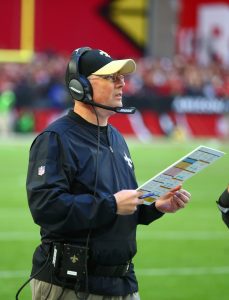 The Broncos having a 2026 franchise tag represents a negotiating tool, of course. Regardless, Surtain figures to follow Champ Bailey in being an elite corner tied to the Broncos long term.
The Broncos having a 2026 franchise tag represents a negotiating tool, of course. Regardless, Surtain figures to follow Champ Bailey in being an elite corner tied to the Broncos long term.
Carmichael joins OC Joe Lombardi in working under Payton in New Orleans. One of the longest-tenured coordinators in NFL history, Carmichael spent 15 years as the Saints’ OC. Twelve of those came under Payton, with the veteran OC calling plays during the HC’s 2012 Bountygate ban and over the past two years. Carmichael, 52, was Lombardi’s boss for 10 seasons. This trio, which was together as Brees moved from an inconsistent Chargers career to first-ballot Hall of Famer, will attempt to develop Nix.
Shaw may have a role here as well, but the former Stanford leader — who interviewed for the Denver HC job in 2023 and worked with Payton back on Ray Rhodes‘ 1997 Eagles staff — is set to work under Paton in a front office role.
Top 10 cap charges for 2024:
- Garett Bolles, LT: $20MM
- Courtland Sutton, WR: $17.3MM
- D.J. Jones, DT: $12.99MM
- Zach Allen, DL: $7.7MM
- Mike McGlinchey, RT: $7.4MM
- Alex Singleton, LB: $7.33MM
- Tim Patrick, WR: $7.2MM
- Jarrett Stidham, QB: $7MM
- Patrick Surtain, CB: $6.7MM
- Ben Powers: $6.55MM
Expectations are low for this Broncos edition. The Wilson albatross hindered the team’s ability to build a roster this offseason, but even after the Simmons and Jeudy exits, a number of quality vets are still in place. Nix’s development will define this season, with a grueling AFC making a ninth straight playoff absence more likely than not.
Nix being a quick study could change the equation, and Payton’s play-calling certainly helped Wilson recover — to a degree, at least. This season will also probably provide a clearer picture of Payton’s offense in Denver, as Wilson’s style clashed with the HC’s designs. A veteran-laden O-line is in place to protect the rookie, though the Broncos do not appear well-equipped for weaponry. From a roster-construction perspective, this is certainly a fascinating period for a franchise that has seen its QB decisions impede veteran nuclei before.
